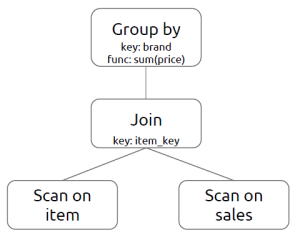About
A execution plan is an ordered set of steps to execute a query
During SQL processing, the row source generator receives the optimal execution plan from the optimizer and produces an iterative plan, called the query plan, that is usable by the rest of the database.
The iterative plan is a binary program that, when executed by the SQL virtual machine, produces the result set.
The actual execution plan is produced by the optimizer whereas the query plan is an iterative execution plan produced after in the SQL processing steps by the row source generator.
Also known as SQL Engine - How to read a physical plan (Execution Plan | Execution Tree)
Articles Related
Logical Query Plan Example
Read data from storage, and then do join on some join keys, and finally aggregate with some aggregation keys
Relational algebra
Every query is represented as a tree of relational operators. You can translate from SQL to relational algebra, or you can build the tree directly.
Planner rules transform expression trees using mathematical identities that preserve semantics. For example, it is valid to push a filter into an input of an inner join if the filter does not reference columns from the other input.
For instance, you can optimizes queries by repeatedly applying planner rules to a relational expression. A cost model guides the process, and the planner engine generates an alternative expression that has the same semantics as the original but a lower cost.
A query with an Aggregate, and a Filter:
final RelNode node = builder
.scan("EMP")
.aggregate(builder.groupKey("DEPTNO"),
builder.count(false, "C"),
builder.sum(false, "S", builder.field("SAL")))
.filter(
builder.call(SqlStdOperatorTable.GREATER_THAN,
builder.field("C"),
builder.literal(10)))
.build();
System.out.println(RelOptUtil.toString(node));
is equivalent to SQL
SELECT deptno, count(*) AS c, sum(sal) AS s
FROM emp
GROUP BY deptno
HAVING count(*) > 10
and produces the following query plan
LogicalFilter(condition=[>($1, 10)])
LogicalAggregate(group=[{7}], C=[COUNT()], S=[SUM($5)])
LogicalTableScan(table=[[scott, EMP]])

